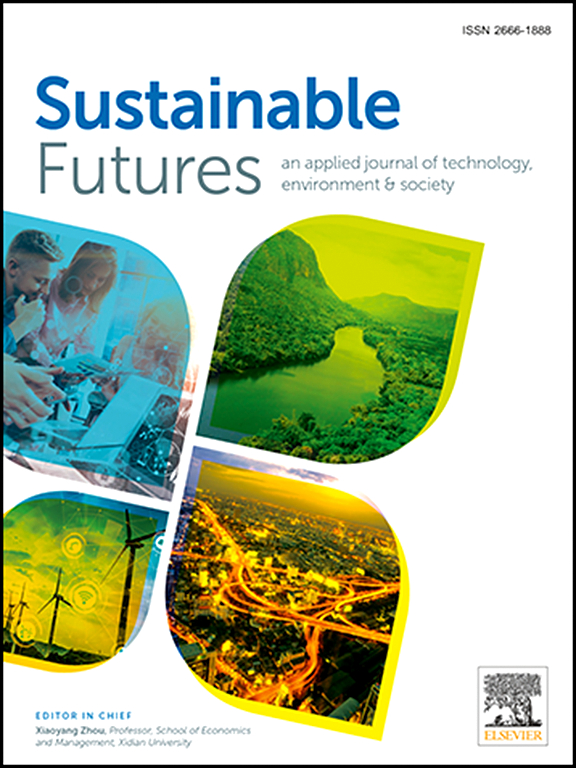Impact of credit constraints on adoption of biofortified food crop among farming households in Nigeria
IF 3.3
2区 社会学
Q2 ENVIRONMENTAL SCIENCES
引用次数: 0
Abstract
The prevalence of credit constraints has a significant effect on the adoption of biofortified cassava; hence, low productivity on farms. This research, therefore, investigates the effect of credit constraints on the adoption of biofortified cassava (BC) among farming households. A multistage sampling procedure is employed to select 300 cassava farming households for this study. Data is analyzed using descriptive statistics, seemingly unrelated regression, and endogenous switching regression model. The results show that most of the household heads (78%) are not constrained by credit while 22% of respondents are constrained by credit. Out of the 22% that are constrained by credit, 7% are ‘quantity’ constrained (they receive partial credit) while 7.5% are both ‘risk’ (they choose not to submit their applications due to concerns about losing their collateral) and ‘price’ (they do not apply because of high interest rate) constrained. The seemingly unrelated regression model reveals that marital status, household size, years of education and farming experience significantly influenced quantity constraint status; while age, relationship with household head, farming experience and access to information are factors that contribute to the risk constraint status of farming households. The conditional treatment effect (ATT), which assesses the effect of credit constraints on the adoption of BC among farming households, is approximately -11.4 and is statistically significant at 1 %. The study finds that credit constraint has a negative impact on the adoption of BC among farming households in Nigeria after adjusting for both observable and unobserved factors. Therefore, the study recommends that innovative financing mechanisms should be leveraged to help promote the adoption of agricultural technologies such as BC. This will help to improve the nutrition, food security and income of farming households.
信贷限制对尼日利亚农户采用生物强化粮食作物的影响
普遍存在的信贷限制对采用生物强化木薯有重大影响;因此,农场的生产率很低。因此,本研究调查了信贷限制对农户采用生物强化木薯(BC)的影响。采用多阶段抽样方法,选取300户木薯农户进行研究。数据分析采用描述性统计、看似不相关回归和内生转换回归模型。结果显示,大多数户主(78%)不受信贷约束,而22%的受访者受到信贷约束。在22%受到信贷限制的人中,7%受到“数量”限制(他们获得部分信贷),而7.5%同时受到“风险”(他们由于担心失去抵押品而选择不提交申请)和“价格”(他们由于高利率而不申请)的限制。看似不相关的回归模型显示,婚姻状况、家庭规模、受教育年限和务农经验对数量约束状态有显著影响;而年龄、与户主的关系、务农经验和信息获取是农户风险约束状况的影响因素。有条件待遇效应(ATT),评估信贷约束对农户采用BC的影响,约为-11.4,在统计上显著为1%。研究发现,在对可观察因素和不可观察因素进行调整后,信贷约束对尼日利亚农户采用BC产生了负面影响。因此,该研究建议利用创新的融资机制来帮助促进BC等农业技术的采用。这将有助于改善农民家庭的营养、粮食安全和收入。
本文章由计算机程序翻译,如有差异,请以英文原文为准。
求助全文
约1分钟内获得全文
求助全文
来源期刊

Sustainable Futures
Social Sciences-Sociology and Political Science
CiteScore
9.30
自引率
1.80%
发文量
34
审稿时长
71 days
期刊介绍:
Sustainable Futures: is a journal focused on the intersection of sustainability, environment and technology from various disciplines in social sciences, and their larger implications for corporation, government, education institutions, regions and society both at present and in the future. It provides an advanced platform for studies related to sustainability and sustainable development in society, economics, environment, and culture. The scope of the journal is broad and encourages interdisciplinary research, as well as welcoming theoretical and practical research from all methodological approaches.
 求助内容:
求助内容: 应助结果提醒方式:
应助结果提醒方式:


